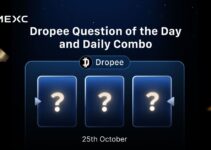Executive Summary
Monad (MON) became a focal point for market attention after a high-profile crypto executive reversed public support while large holders continued to accumulate. On-chain analytics indicate that whales now control more than 300 million MON following rapid post-mainnet flows. Simultaneous reports of spoofed transfers and simulated swap activity contributed to price volatility. This article outlines the on-chain developments, the executive’s apparent rotation into other tokens, and the broader market context for 2025 that may influence MON and similar low-FDV Layer-1 tokens.

Recent Market Developments
Within days of Monad’s mainnet launch, MON saw a sharp post-launch rally followed by a correction. Public commentary from an influential market figure accelerated headlines when they publicly withdrew support for the token and encouraged traders to re-evaluate their positions.
Despite the public exit, blockchain records show sizable accumulation by top-tier addresses. Several large addresses recorded multi-million token inflows, and a significant withdrawal from a centralized exchange was logged as part of the accumulation wave.
Key on-chain indicators
- Aggregated whale holdings now exceed 300 million MON.
- High-tier addresses increased balances by double-digit percentages over a short time window.
- Major single-address withdrawals from a centralized exchange were recorded, representing one of the largest single accumulations in the token’s recent history.
Public Commentary Versus On-Chain Behavior
The divergence between vocal market commentary and on-chain activity is notable. After publicly criticizing the token and signaling an exit, the executive appears to have redeployed capital into a set of other projects.
Documented portfolio rotation
- Significant purchases of ENA (Ethena) and PENDLE were observed.
- Accumulation of ETHFI and other liquid-staking or “real yield” oriented tokens was reported shortly after the MON exit.
- Transactions suggest a strategy shift away from high-FDV, hype-driven Layer-1 narratives toward protocols emphasizing yield mechanics and staking primitives.
The sequence of selling or disavowing a token publicly while other large holders increase exposure can create mixed signals for retail traders and market makers. This behavior reinforces the need for independent research and monitoring of on-chain flows rather than relying solely on public commentary.
Spoofed Transfers and Post-Mainnet Volatility
One complicating factor in MON’s early trading period has been the prevalence of spoofed on-chain activity. Bad actors have used techniques that generate simulated transfers and fake swap calls to make wallets appear active, often during peak discovery hours just after mainnet launches.
How spoofed transfers work
- Adversary contracts emit event logs that mimic legitimate ERC-20 transfer events without actual balance movement.
- Fraudulent contracts can call swap-related functions to create the illusion of liquidity and trading volume.
- These simulated patterns can mislead observers who rely on transaction counts and event logs to gauge momentum.
Such spoofing can exacerbate volatility as retail participants and automated monitors misread the level of genuine market interest. In MON’s case, the timing of these simulated activities aligned with the initial wallet claims and liquidity discovery window, amplifying uncertainty.
Price Impact and Short-Term Performance
Mond’s price pulled back from its initial highs, reflecting both the speculative nature of early L1 launches and the impact of negative headlines. At the time of reporting, MON was trading lower than at its peak, with a notable intraday decline tied to the combination of public exit messaging and spoofed on-chain signals.
Early-stage tokens frequently experience elevated volatility due to low circulating liquidity, concentrated holdings, and information asymmetry between retail and institutional participants.
Why Whales May Continue to Accumulate
Despite public criticism, large holders often accumulate for several reasons:
- Anticipation of long-term token utility or protocol upgrades that could increase value.
- Belief in future liquidity events or exchange listings that may lift market depth.
- Arbitrage opportunities between on-chain prices and off-chain order books.
- Contrarian accumulation during price dips induced by headline-driven sell pressure.
In 2025, many large holders have sharpened strategies around selective accumulation during dislocations, emphasizing on-chain diligence and custody strategies that allow them to absorb supply quietly.
2025 Market Context and How It Matters for MON
The broader crypto market environment in 2025 is defined by a few clear themes that affect tokens like MON:
1. Rotation Toward Real Yield and Liquid Staking
Post-2024 market stabilization encouraged flows into protocols that deliver sustainable yield, such as liquid-staking derivatives and mechanisms that capture protocol revenue. Tokens with clear yield pathways and composability within the staking economy drew renewed institutional interest.
2. Lower Volatility, Higher Importance of Spot Flows
With speculative leverage reduced across many venues and macro volatility moderating, spot flows — especially those driven by whales and OTC desks — now have an outsized impact on price direction for low-liquidity tokens.
3. Regulatory Focus and Exchange Listing Dynamics
Regulatory developments in 2025 continued to influence token listings and institutional participation. Tokens that can demonstrate robust compliance postures and clear governance frameworks tend to attract more conservative capital allocations.
4. Increasing Sophistication of On-chain Analytics
Market participants in 2025 rely heavily on advanced on-chain analytics to distinguish genuine activity from noise. Identifying true accumulation versus simulated transfers has become core to trading strategies.
Risk Considerations for Traders
Investors and traders should consider several risks when navigating MON and similar tokens:
- Concentration risk: Large holders controlling significant supply can influence prices materially.
- On-chain deception: Spoofed transfers and simulated swaps can mislead momentum-based strategies.
- Liquidity risk: Early-stage L1 tokens frequently have fragmented liquidity, increasing slippage for larger orders.
- Information asymmetry: Public commentary by influential figures may not reflect their on-chain positions.
Risk management best practices include position sizing, using limit orders to control entry and exit prices, and monitoring both on-chain flows and centralized order book depth.
Practical Steps for Monitoring MON
To better assess the MON market, traders may:
- Track large wallet addresses to observe accumulation trends and shifts in concentration.
- Use multiple on-chain analytics sources to cross-verify transfer and swap event integrity.
- Monitor exchange inflows and outflows to detect potential distribution from centralized custody.
- Follow protocol announcements and tokenomics changes that could alter supply dynamics.
MEXC Perspective and Best Practices
At MEXC, market integrity and investor protection are priorities. For participants considering exposure to early-stage tokens:
- Conduct independent research into token utility, team credibility, and on-chain metrics.
- Consider diversified exposure rather than concentrated bets in a single token.
- Leverage platform tools for limit orders, stop orders, and portfolio analytics to manage downside risk.
- Stay informed about market structure developments and regulatory updates that could affect listing eligibility and liquidity.
Conclusion
Monad’s recent episode underlines a 2025 market reality: public commentary and on-chain behavior do not always align. While a prominent executive publicly exited MON, whales increased their holdings, and spoofed transfer activity complicated price discovery. Traders should prioritize on-chain verification, diversified risk strategies, and disciplined execution when navigating tokens with concentrated supply and nascent liquidity.
As the market evolves through 2025, expect continued rotations toward yield-bearing and liquid-staking protocols, greater scrutiny of early L1 launches, and the need for sophisticated analytics to separate signal from noise. Investors are advised to perform their own research and consider multiple data sources before acting.
Disclaimer: This post is a compilation of publicly available information.
MEXC does not verify or guarantee the accuracy of third-party content.
Readers should conduct their own research before making any investment or participation decisions.
Join MEXC and Get up to $10,000 Bonus!
Sign Up


